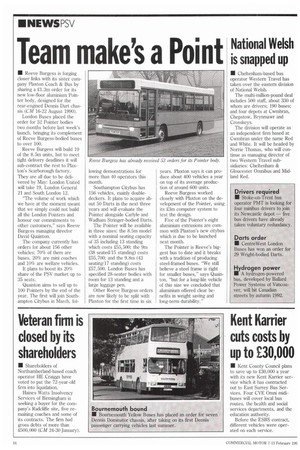Team make's a Point
Page 24

If you've noticed an error in this article please click here to report it so we can fix it.
• Reeve Burgess is forging closer links with its sister company Plaxton Coach & Bus by sharing a 21.3m order for its new low-floor aluminium Pointer body, designed for the rear-engined Dennis Dart chassis (CM 16-22 August 1990).
London Buses placed the order for 52 Pointer bodies two months before last week's launch, bringing its complement of Reeve Burgess-bodied buses to over 100.
Reeve Burgess will build 19 of the 8.5m units, but to meet tight delivery deadlines it will sub-contract the rest to Plaxton's Scarborough factory. They are all due to be delivered by May: London United will take 19, London General 21 and South London 12.
The volume of work which we have at the moment meant that we simply could not build all the London Pointers and honour our commitments to other customers," says Reeve Burgess managing director David Quainton.
The company currently has orders for about 156 other vehicles; 70% of them are buses, 20% are mini coaches and 10% are welfare vehicles.
It plans to boost its 20% share of the PSV market up to 35 seats.
Quainton aims to sell up to 100 Pointers by the end of the year. The first will join Southampton Citybus in March, fol lowing demonstrations for more than 40 operators this month.
Southampton Citybus has 156 vehicles, mainly doubledeckers. It plans to acquire about 50 Darts in the next three years and will evaluate the Pointer alongside Carlyle and Wadham Stringer-bodied Darts.
The Pointer will be available in three sizes: the 8.5rn model with a nominal seating capacity of 35 including 13 standing which costs £55,500; the 9m (38 seated/15 standing) costs £55,700; and the 9.8m (43 seating/17 standing) costs .257,500. London Buses has specified 28-seater bodies with room for 13 standing and a large luggage pen.
Other Reeve Burgess orders are now likely to be split with Plaxton for the first time in six years. Plaxton says it can produce about 400 vehicles a year on top of its average production of around 600 units.
Reeve Burgess worked closely with Plaxton on the development of the Pointer, using its 23m computer system to test the design.
Five of the Pointer's eight aluminium extrusions are common with Plaxton's new citybus which is due to be launched next month.
The Pointer is Reeve's biggest bus to date and it breaks with a tradition of producing steel-framed buses. "We still believe a steel frame is right for smaller buses," says Quainton, ''but for a long-life vehicle of this size we concluded that aluminium offered clear benefits in weight saving and long-term durability."




















































































































